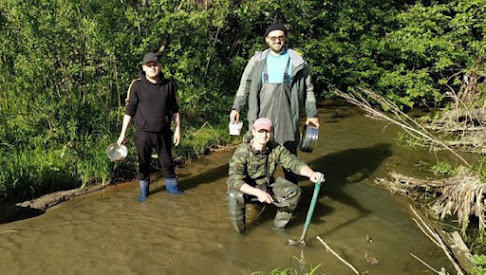 |
| Credit: Ural Federal University |
Paleontologists from the Institute of Plant and Animal Ecology of the Ural Branch of the Russian Academy of Sciences and Ural Federal University Dmitry Gimranov and Anton Kisagulov together with volunteers discovered teeth and bones of ancient Eocene animals in the Sverdlovsk Region (the Sugat River near the village of Talitsa). Most of the finds are 40 million years old. There are also later finds dating back to the Middle or Late Pleistocene (0.75-0.02 million years). The oldest finds were numerous and consisted mainly of shark and ray teeth and fish bones. The "mammoth time" finds were few and include bones of frogs, birds and mammals. Late finds will have to be dated by radiocarbon analysis.
Shark and ray teeth will be transferred for study to Tatyana Malyshkina, a Senior Researcher at the Laboratory of Stratigraphy and Paleontology at the Zavaritsky Institute of Geology and Geochemistry of the Ural Branch of the Russian Academy of Sciences. The finds will enrich her collection with new specimens and possibly serve as a basis for the description of new species. The mammal finds will be studied by Dmitry Gimranov, a Senior Researcher at the Paleoecology Laboratory of the Institute of Plant and Animal Ecology of the Ural Branch of the Russian Academy of Sciences and the Laboratory of Natural Science Methods in Humanities of the UrFU.
 |
| Most of the remains are thought to be 40 million years old Credit: Ural Federal University |
"Among the mammals, the tooth of the badger deserves special attention. According to organoleptic indicators, the tooth completely corresponds to late Pleistocene preservation, i.e. to the period of 120-20 thousand years, when mammoths lived. If it turns out that it is so, then the finding becomes extremely important and interesting, because the remains of badgers of Pleistocene time in the Urals and Siberia are almost never found. There are only a few finds in several caves in the Urals," explains Dmitry Gimranov.
The biology of the ancient badger is extremely poorly studied, as this animal was rare in the late Pleistocene, when the climate was colder and drier. Paleontologists also include otter, roe deer and elk among such rare species in the Pleistocene. Badger, just like roe deer and elk, is a forest animal, and forests in the Ural in the late Pleistocene apparently covered a much smaller area than they do now. Therefore, all forest animals of that time are rare in Late Pleistocene sediments and are of particular interest to scientists.
The fact that there was a sea in the Middle Urals and Western Siberia in the Eocene (40 million years ago) was confirmed by scientists long ago. Therefore, according to researchers, it is often possible to find shark teeth, rays, and fish bones from that time in the Urals.
Source/Credit: Ural Federal University
pal060622_01







.jpg)